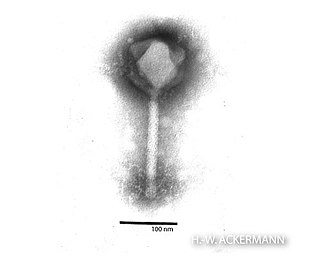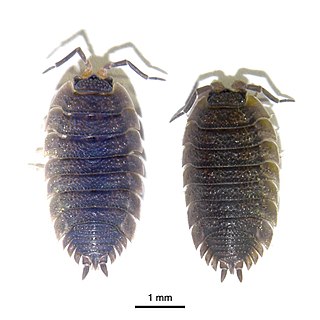
Podoviridae is a family of bacteriophage in the order Caudovirales often associated with T-7 like phages. There are 130 species in this family, assigned to 3 subfamilies and 52 genera. This family is characterized by having very short, noncontractile tails. Podoviradae are largely understudied and most new isolates are of the phicbkviruses genus, a group of giant viruses that appear to be Caulobacter specific.

Nanoviridae is a family of viruses. Plants serve as natural hosts. There are currently 12 species in this family, divided among 2 genera and one unassigned species. Diseases associated with this family include: stunting. Their name is derived from the Greek word νᾶνος, because of their small genome and their stunting effect on infected plants.

Potyviridae is a family of positive-strand RNA viruses that encompasses more than 30% of known plant viruses, many of which are of great agricultural significance. The family has 12 genera and 235 species, three of which are unassigned to a genus.

Parapoxvirus is a genus of viruses, in the family Poxviridae, in the subfamily Chordopoxvirinae. Like all members of the family Poxviridae, they are oval, relatively large, double-stranded DNA viruses. Parapoxviruses have a unique spiral coat that distinguishes them from other poxviruses. Parapoxviruses infect vertebrates, including a wide selection of mammals, and humans.
Avihepadnavirus is a genus of viruses, in the family Hepadnaviridae. Birds serve as natural hosts. There are three species in this genus. Diseases associated with this genus include: hepatitis, hepatocellular carcinomas, and cirrhosis.

Iridoviridae is a family of viruses with double-stranded DNA genomes. Amphibians, fish, and invertebrates such as arthropods serve as natural hosts. There are currently 22 species in this family, divided among two subfamilies and seven genera.

Corticovirus is a genus of viruses in the family Corticoviridae. Corticoviruses are bacteriophages; that is, their natural hosts are bacteria. The genus contains two species. The name is derived from Latin cortex, corticis. However, prophages closely related to PM2 are abundant in the genomes of aquatic bacteria, suggesting that the ecological importance of corticoviruses might be underestimated. Bacteriophage PM2 was first described in 1968 after isolation from seawater sampled from the coast of Chile.

Ascoviridae is a family of double strand DNA viruses that infect primarily invertebrates, mainly noctuids and spodoptera species; it contains two genera, Ascovirus, which contains three species, and Toursvirus with a single species Diadromus pulchellus toursvirus.

Ranavirus is a genus of viruses, in the family Iridoviridae. There are six other genera of viruses within the family Iridoviridae, but Ranavirus is the only one that includes viruses that are infectious to amphibians and reptiles. Additionally, it is one of the three genera within this family which infect teleost fishes, along with Lymphocystivirus and Megalocytivirus.

Orthohepadnavirus is a genus of viruses, in the family Hepadnaviridae. Humans and other mammals serve as natural hosts. There are 12 species in this genus. Diseases associated with this genus include: hepatitis, hepatocellular carcinoma, and cirrhosis.
Yatapoxvirus is a genus of viruses, in the family Poxviridae, in the subfamily Chordopoxvirinae. Monkeys and baboons serve as natural hosts. There are two species in this genus. Diseases associated with this genus include: histiocytomas, tumor-like mass of mononuclear cells.
Megalocytivirus is a genus of viruses in the family Iridoviridae and one of three genera within this family which infect teleost fishes, along with Lymphocystivirus and Ranavirus. Megalocytiviruses are an emerging group of closely related dsDNA viruses which cause systemic infections in a wide variety of wild and cultured fresh and saltwater fishes. Megalocytivirus outbreaks are of considerable economic importance in aquaculture, as epizootics can result in moderate fish loss or mass mortality events of cultured fishes.
Lymphocystivirus is a genus of viruses, in the family Iridoviridae. Fish serve as natural hosts. There are four species in this genus. Diseases associated with this genus include: tumor-like growths on the skin.
Entomopoxvirinae is a subfamily of viruses, in the family Poxviridae. Insects, human, vertebrates, and arthropods serve as natural hosts. There are currently 31 species in this subfamily, divided among 4 genera with one species unassigned to a genus. Diseases associated with this subfamily include: impairment of motility and development.
Mastadenovirus is a genus of viruses in the family Adenoviridae. Humans and other mammals serve as natural hosts. There are 51 species in this genus. The genus as a whole includes many very common causes of human infection, estimated to be responsible for 2 to 5% of all respiratory infections, as well as gastrointestinal and eye infections. Symptoms are usually mild.
Chloriridovirus is a genus of viruses, in the family Iridoviridae. Diptera with aquatic larval stage, mainly mosquitoes, lepidoptera, and orthoptera insects serve as natural hosts. There are five species in this genus. Diseases associated with this genus include: yellow-green iridescence beneath the epidermis. Death rates are highest in the fourth instar. Viruses within this genus have been found to infect mosquito larvae, in which they produce various iridescent colors.
Twortvirus is a genus of viruses in the order Caudovirales, in the family Herelleviridae, in the subfamily Twortvirinae. Bacteria serve as natural hosts. There is only one species in this genus: Staphylococcus virus Twort.

Phikzvirus is a genus of viruses in the order Caudovirales, in the family Myoviridae. Bacteria serve as natural hosts. There are three species in this genus.
Aquabirnavirus is a genus of viruses, in the family Birnaviridae. Salmonid fish serve as natural hosts. There are three species in this genus. A disease associated with this genus, Infectious pancreatic necrosis (IPN) in salmonid fish, causes significant losses to the aquaculture industry. Chronic infection in adults, and acute viral disease in young salmonid fish can occur.

Invertebrate iridescent virus 31 (IIV-31), also known informally as isopod iridovirus, is a species of invertebrate iridescent virus in the genus Iridovirus. Oniscidea serve as hosts. Infection is associated with decreased responsiveness in the host, increased mortality, and most strikingly, the emergence of an iridescent blue or bluish-purple colour due to the reflection of light off a paracrystalline arrangement of virions within the tissues.












